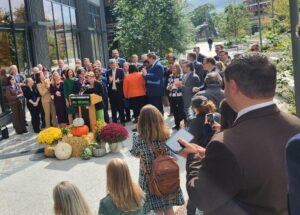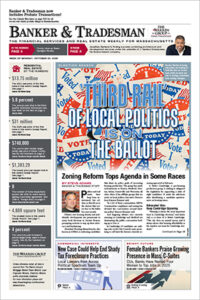
Gov. Maura Healey, Lt. Gov. Kim Driscoll and Attorney General Andrea Campbell touted compliance with the MBTA Communities law on Oct. 1, 2024 ahead of a high-stakes court battle over the law between the state and the town of Milton. Photo by Gintautas Dumcius | CommonWealth Beacon
If political happy talk could be converted into housing units, the cost of a typical home wouldn’t be nearing $1 million in Greater Boston.
But it’s a reality our state and local pols seem incapable of grasping.
The latest example? Last Tuesday’s big gathering of state and local leaders in Somerville to mark a milestone of sorts, with 75 cities and towns across the region having approved the new multi-family zoning required under the 2021 MBTA Communities law.
It was clearly an attempt to make a big statement, with Gov. Maura Healey, Lt. Gov. Kim Driscoll, Attorney General Andrea Campbell, state housing chief Ed Augustus and a host of local officials from towns and suburbs across the region all attending the Union Square event.
The timing of the event was no coincidence either, coming as state’s highest court prepares to hear a challenge of the new law on Monday by Milton, one of a small but growing number of communities that have rejected the new rules outright.
Neither was the choice of venue, with the event taking place in front of a 450 unit, mixed-income apartment building in Somerville, which complied with the MBTA Communities Law by effectively legalizing triple-deckers throughout the city.
Driscoll, the former mayor of Salem and the governor’s point person on housing, offered the most bullish comments.
“We are winning this fight for housing,” Driscoll said, per CommonWealth Beacon. “We’re not going to stop here.”
Campbell, the AG whose office is defending the MBTA Communities law in court, touted “the incredible momentum behind the incredible MBTA Communities law,” CommonWealth reported.
Healey, in the release sent out by her press staffers after the event, also touted the supposed “momentum” behind the new law.
Well, if this what momentum looks like, we are going to need a lot more of it, and fast.
While 75 communities may sound like a lot, that’s not even half of the 177 cities and towns required to pass new zoning rules and open their doors to new apartments, condos and townhomes.
An even smaller number of communities, about three dozen, have managed to get the required state approval for their zoning plans as state housing officials test the growing pile of new zoning rules to see if it meets their standards.
Towns Pick Undevelopable Sites
While only a handful of communities are outwardly challenging the new law, a larger number are focusing on paper compliance with the law while attempting to make it as difficult as possible to actually builders, developers and zoning experts have noted.
Tactics include creating a new MBTA Communities multifamily zoning district atop an already built out neighborhood or industrial area.
Malden officials created a zoning district that allowed for 10-story residential towers – covering only four parcels already home to one 10-story building, two 12-story buildings and one 20-story tower.
In Brookline, YIMBY and NIMBY groups compromised on upzoning the town’s Harvard Street retail strip to allow 4-story buildings, only to have a developer apply for an exemption soon after to build a 6-story building because, as the builder’s lawyer told town officials, the “numbers didn’t crunch” since local construction costs are even higher than that Malden tower.
Boston Indicators, the research arm of the Boston Foundation, said earlier this year that all this obeying the letter but not the spirit of the MBTA Communities law might produce as little as 20,000 new units when the state, by the Healey administration’s own estimates, needs 10 times that number.
There’s Only One Measure of Progress
Legal victories and votes by local communities to adopt new zoning rules are cold comfort for middle- and working-class families priced out of the housing market and weighing plans to leave Massachusetts for New Hampshire, Florida or any one of a number of less-costly states to live in.
At the end of the day, the only real measure of progress when it comes to solving the housing crisis, and that’s lots of new homes, apartments and condominiums.
If anything, Boston and the state as a whole have seen a significant drop in new residential construction over the past two years amid high interest rates and high construction costs.
Across the board, it’s been about a 30 percent drop over the past two years since the Fed began hike rates to bring down inflation. It’s even worse when you consider the fact that the housing market was already starved for new listings and inventory before the rate increases.
So when will we know we are finally coming grips with our state’s obscenely unaffordable housing market?
When our pols start talking about real numbers like these and ditch all the happy talk.
Scott Van Voorhis is Banker & Tradesman’s columnist and publisher of the Contrarian Boston newsletter; opinions expressed are his own. He may be reached at sbvanvoorhis@hotmail.com.





